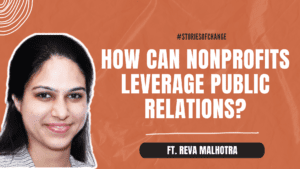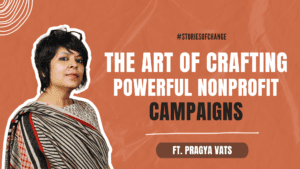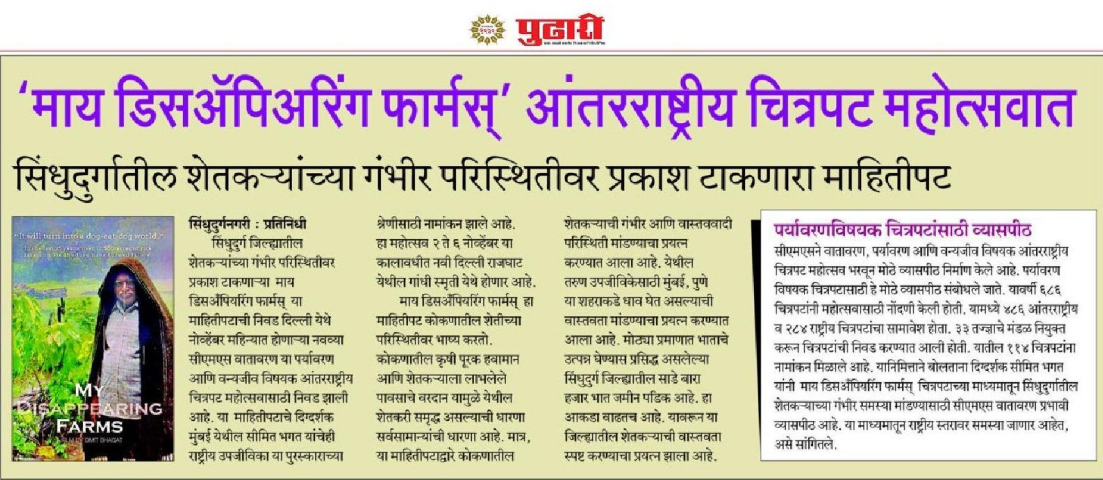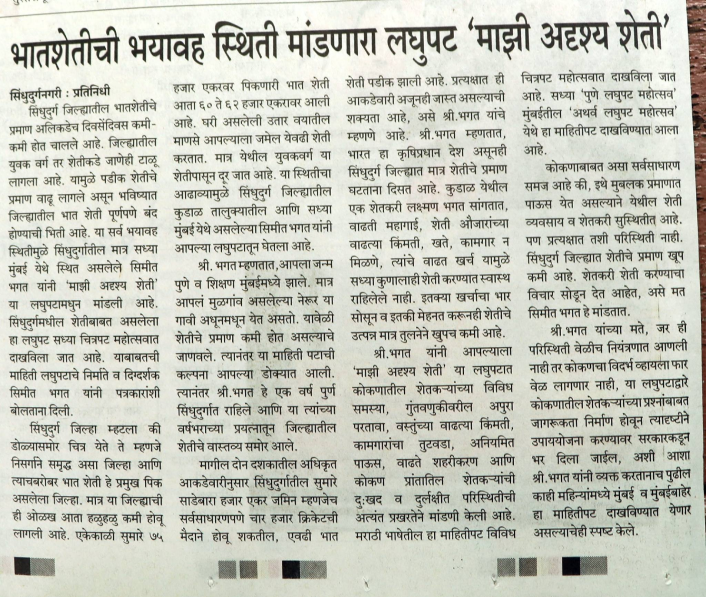In this episode of ‘Stories of Change’, Kavita discusses the impact and significance of Giving Tuesday within India’s nonprofit landscape. Our discussion delves into a variety of topics, including strategies used by change makers to maximise their fundraising efforts, the pivotal role of storytelling and how to address donor fatigue (if it exists).
Kavita has previously worked as an India partnerships consultant for GlobalGiving, the world’s largest nonprofit crowdfunding platform. During her time there, she significantly expanded GlobalGiving’s presence and impact in India. Before her nonprofit career, Kavita was an investment banker at Goldman Sachs. Beyond her professional roles, Kavita actively supports nonprofits as a fundraising consultant and offers guidance to her startup entrepreneurial friends.
Transcript of the Episode:
Simit: Thank you Kavita for joining on this podcast. It’s really a pleasure to have you here.
Kavita: Thank you so much for having me.
Simit: I want to understand from you, how do you see the overall kind of fundraising space in India? And also if you could place the GivingTuesday in that context.
Kavita: The Indian nonprofit sector is at a tipping point at the moment. And I feel like with individual fundraising and lots of new technology coming in to support and help nonprofits in their journey in retail fundraising, it’s only going to get bigger and better. Now, to put GivingTuesday in that context, GivingTuesday is a global generosity movement. It unleashes the power of radical generosity around the world. And what radical generosity means is that the suffering of another person is as intolerable to me as my own suffering or the suffering of a loved one. And it’s radical generosity that really pushes you to take action. Now, GivingTuesday’s core belief is that everyone has something to give and every act of generosity counts.
“GivingTuesday’s core belief is that everyone has something to give and every act of generosity counts.”
It’s a very simple idea, and this idea was created in 2012 as just something really simple. It encourages everyday people and everyone to do good and to celebrate the inherent value of generosity.
But today, 11 years later, it has grown into a global movement. It inspires hundreds of millions of people to give, to collaborate and celebrate generosity, not just on that single day, but all year round. And the movement is actually led by entrepreneurial leaders. Are all, I mean, technically speaking, volunteers because they have other full time jobs. And these entrepreneurial leaders need national movements in about 85 plus countries around the world. And people and organisations in almost every single country do some kind of activation or participation for GivingTuesday.
Now, GivingTuesday has led to billions of dollars worth of donations to civil society, but also countless acts of generosity, kindness, civic participation all over the world. And last year alone, on GivingTuesday about 3.1B with a billion, that’s 3 billion with a B were donated to charitable organisations. And what’s important to note is that most of this is made up of $100. That’s like ₹4000 to ₹8000. That’s the average donation size, and it’s given by everyday individuals, not large philanthropic institutions. So GivingTuesday, in short, harnesses the power of that, the everyday givers. And what’s important to remember is people don’t just give money. They give their talents, their time, their voice. And it’s so many different things.
Simit: Yeah. So how does it actually work? While I understand that it’s a movement, but how does it work in actual practice?
Kavita: There are different ways in which you can participate in GivingTuesday, and I’m assuming a lot of people listening in are nonprofits. So as a nonprofit, you can leverage the momentum, the wave of giving that would be happening during giving moments like GivingTuesday. So you can fundraise for your organisations, you can get new volunteers for your organisations. You’re basically using GivingTuesday as a way to access a new set of donors or engage with your current existing donors.
“Nonprofits use Giving Tuesday as a way to mobilise resources.”
So nonprofits use it as a way to mobilise resources. But we also see businesses getting involved and using it as a way to engage with their clients in a more meaningful manner, engage with the employees, and giving them employees a chance to do something more meaningful and of social impact.
We are seeing networks of individuals, networks and associations and clubs coming together to use it as a day to do something. So we see participation in GivingTuesday in different ways, but GivingTuesday is actually led by leaders, like I mentioned earlier, who are all people with other full time jobs, who have taken it up as their passion project to drive more generosity in their communities.
Simit: In your own experience with GivingTuesday, what are the strategies that organisations have used in order to leverage the giving movement?
Kavita: You know, to be honest, when looking back, the ones that have really stood out for me are the ones that gave people creative ways to get engaged rather than just make a donation. Today, it’s GivingTuesday, and I think you’ve touched on something really important, that fundraising is really like giving people an opportunity to be a part of building the world that they want to live in, that it’s not just about come and give money to find a solution for X, Y, Z, but you’re actually calling people you’re starting a movement, you’re calling people to come be a part of this new world that we want, we can build together. And those are the ones that really stood out for me.
“Fundraising is really like giving people an opportunity to be a part of building the world that they want to live in.”
So to give you some examples. There is an organisation called YearUp. The organisation added a personal touch point by again holding a volunteer led phonethon. In this case, it was not a thankathon, but they set a goal of about 500 gifts. That’s 500 donations that they wanted to get on that single day. They also managed to get a pretty good sum as matching gift from a family foundation. So they use that to their advantage as well. And at the end of the day, the were able to get 615 gifts and went over that goal. What they raised was about $240,000 to advance their mission. So that’s something creative that I’ve seen.
I have an Indian example from last year. It’s a Punjab based organisation called Sanjhi Sikhiya. They managed to raise ₹70 lakhs from more than 250 supporters, and this was part of their annual fundraiser. It ended on GivingTuesday. So they used GivingTuesday as a bookend and motivated people to give until that day. They use that as a kind of a grand finale.
There’s another like really fun one, which is from Malaysia, a nonprofit got university students who are volunteering with them. They all I mean, this idea came from the students themselves. They had a spicy noodle challenge. So what they did was the fundraisers that the volunteers eat progressively spicier noodles as their friends increase their donations. So people do fun things as well.
One that I would really highlight, which I would love to see happen around the world, is raising funds for another organisations on Giving Tuesday or one day. There are real life examples. There’s an organisation called Help International. Their team decided to fundraise for another organisation that was working on a big refugee crisis at that time. And this really eases out the competition that we often talk about an experience in the sector that that toxic notion of competition and reminds us that at the end of the day, we’re all trying to build a better world. We’re all in this together. And I mean, this is something I would love to see if all organisation used one day to just fundraise for another organisation, that would be so amazing.
Simit: But that actually also brings me to my next question. We talked about what are the strategies that organisations use in the fundraising space? I want to delve a little bit more into what are the typical mistakes or things that nonprofits could improve on as far as their fundraising strategies are concerned.
Kavita: I can talk about a few – over emphasis on social media. Social media is very important, don’t get me wrong. It’s very important. I feel like sometimes we get overwhelmed with new platforms that are coming up and we need to be everywhere or we will not succeed. I think whatever you do, do it well as opposed to trying to be everywhere all the time and don’t neglect e-mail. Email marketing is still a pretty massive way of getting conversions for nonprofits.
“Email marketing is still a pretty massive way of getting conversions for nonprofits.”
And you know, an average individual is actually subscribed only about 5 to 7 email newsletters from a nonprofit. So at the end of the day, as a fundraiser, you might be thinking that you’re asking too many times, but actually you’re not. That person may have like missed the first ten emails that you sent because you’re sending it into this large clutter. So you need to ask constantly and you need to ask quite often and you need to send the same message multiple times for it to register for a person. Those are also really important things. But I would say when you’re using email marketing, especially try to segment as much as possible. You wouldn’t want to send a mass email to your major donors. You wouldn’t want to send it to your board members, you would want to customise it. And don’t send multiple emails to the person who just gave you.
There are so many automation systems that exist now. So if I were to give you a tip on how to prepare for a giving moment that’s coming up in the next few months or the festive season that’s coming up, I would say talk to some volunteers, get a good CRM system in place so that you are able to automate and make things easier so that you don’t have to spend a lot of time trying to manually do this. It’s important to send ask multiple times, but don’t send it (an email) if a person has already given.
I know you asked about mistakes, but I want to talk about a tip that the digital strategy director at GivingTuesday always talks about. It is something that nobody would have thought about with this calendar invites. If you have a deadline or a day on which you want a person to donate to, you send them a calendar invite. Because to be honest, as a lot of working professionals especially depend on the Google calendars or their Outlook calendars to remind them about things that they need to do on that particular day. Get into that calendar with just a simple calendar invite sent in advance so that on that day they get reminded about whatever it is that you’re asking them to do.
“Calendar invites can be used to encourage donations on a specific day.”
Simit: You actually touched upon two really important things. One is about social media and how a lot of times, we get a lot of queries as well. When organisation come to us, like when they are seeking information about managing their social media because there is a general kind of notion that we should be across all the platforms, whether it is Twitter, Facebook, Instagram, YouTube and so on.
So my question is because I get a lot of newsletters from nonprofits and I have reached a stage where I simply don’t even open it. I just delete it. So I want to ask you about, where does kind of donor fatigue come in because after a certain point, don’t you feel that, donors get long newsletters and after a point, they’re like, okay, I get it, but I don’t want to be seeing this every three days or every week. You know, it has to be like some frequency. So I don’t know. What has been your experience in terms of what is an ideal frequency to send out newsletters and about donor fatigue.
Kavita: And I’m going to say something knowing that it’s going to create some waves and questions in people’s minds, but donor fatigue is actually a myth. What does exist is bad messaging and bad strategy, and I think you kind of justified that with the whole explanation you gave that you said the long newsletters, the title is so boring that I don’t even feel like clicking on it, which is probably why you delete it right and as fundraisers we often hesitate to send out messages multiple times because we feel like that is something called donor fatigue.
But you know, data shows that even in the commercial world you would need something like I think in 2023, it’s like 21 touchpoints to convert someone to take action. And as a fundraiser, we think we are sending out too many appeals when in reality it is just like like I mentioned earlier, this is one email in the inbox that of that potential donor who receives hundreds of emails asking them for different things, not just from nonprofits, but even the commercial world. So are donors fatigued? I don’t think so. What they are is they are not feeling compelled enough.
“So are donors fatigued? I don’t think so. What they are is they are not feeling compelled enough to donate.”
They’re not being asked to give in forms that they want to give in. They’re not feeling engaged and they’re not being asked and engaged in a form that they want to be engaged in right? So as Simit you may not want to give money, but I’m I know, Simit, and I know for sure that you want to give in other ways. Can I get to know you better and understand what form of giving makes more sense for you? What is meaningful for you, and ask in that manner.
Another piece that does exist is fundraiser fatigue, right? So donors are not fatigued. It’s fundraisers that are fatigued because rather than focusing like we are constantly focusing on that bottom line as fundraisers, we are focussed on the metrics because obviously there are needs and then you need to meet your targets and all of that. What if we just centered our attention as fundraisers around fostering a sense of community among donors and building a community for our organisation rather than trying to reach X amount, of course that X amount is important, but what if I just shift something in my brain to tell myself I’m building a community to make this world a better place as opposed to I’m trying to raise 20 crore rupees and think about what it is that you are getting fatigued by. Are there too many events? Are you running too many campaigns? Are you like setting up tables and chairs at a physical event or run like spending half your time just getting virtual event registrations?
Think about what it is that’s really killing you in your fundraising game. Shift that around and try to like focus the sounds very philosophical, but try to focus on the larger goal. right, like remember that you’re doing Why are you doing what you’re doing? At the end of the day, it’s because you want to create this better world and you are working with this organisations because you believe that it is leading to that better world. So yeah, so if you are experiencing fundraiser fatigue, which actually does exist and is not a myth, try to shift that around and I appreciate your perspective. See what it is that you can do that’s different.
Another piece I want to say is about younger donors, especially with in the topic of donor fatigue, younger donors especially, I know a lot of organisation are trying to now focus on younger donors. They want to actually be engaged in more than one way. So if you’re going to send every single email saying give money, give money, give 100%, they’re going to delete your emails. I mean, I don’t think you need to have some like big intelligent AI to help you figure that out. See we need to give people, young people, especially tools to rally their own network and to support the way they want to support you, people want options. People want agency, People want to lead and give in a way that they have control over. So I would say give people options and then see if donor fatigue still exists for your organisations.
“We need to give people, young people, especially tools to rally their own network and to support the way they want to support you.”
Simit: That actually brings me to my next point, which is, at the end of the day, any work that an organisation is doing, there is a story behind it. And organisations need to be good at telling their story. What is the work that they’re doing? What is the kind of impact that they’ve had on an individual, you know, beneficiary, whether it is a girl child or whoever it is, you know, that they are working with.
But for organisations, this is not their strong suit. How can an organisation get around this? And what is in your experience, how storytelling has played an important role when it comes to fundraising and rallying people, you know, getting people to rally behind their cause.
Kavita: Storytelling really helps you carve out something from the work that you do that any individual is able to resonate with, is able to understand and is able to know how they can join you to make a difference and be a part of the solution. So no matter what the goal is for your campaign, Simit, like a compelling story, like you said, is really important. It has to have that contagious energy. What that means is that once a person has read your story or has heard it, they need to be thinking about it. If they are still thinking about that story after you’ve kept the phone down, they’ve closed the email. Now you’ve got that person engaged with the work that you’re doing through that story and your organisations’s goal has become somewhat of a collective goal because you’ve gotten that person to think about it and then at some point they will take action.
“Once a person has read your story or has heard it, they need to be thinking about it.”
And that’s really how you create a movement around your cause, right? And storytelling is such a powerful tool in order to create such a movement because people can’t get their mind wrapped around big numbers. Right? But when you tell a story, they’re able to relate to it much better and see the role they have as individuals as part of the solution.
Again, the Digital strategy director at GivingTuesday. I heard one of her webinars recently and she gave a really good analogy. She spoke about the story of a helicopter. Okay, so imagine that we are sitting in a helicopter, you are sitting in a helicopter and you’re going over a disaster zone. Okay, You see, look down there, it’s flooded. Everything is flooded. And the person sitting next to you said you need to help. Like, what do you do sitting in that helicopter looking down? You’re thinking, how am I going to help? I mean, this place is gone. Let me just go away from here, because whatever I do, the little that I can do as an individual is not going to help. But what if you kind of come down land that helicopter in one small spot that you find and then, you know, you might see someone lying down or asking for food. You go there and help that one person lying on the ground. You will naturally go and lift that person up and help him or her. And that’s doable for me as an individual. And that’s a good analogy to think about when you’re seeing your story.
A lot of times the stories we tell our donors is the story. When you’re high up in the helicopter, 35,000 children are experiencing X, Y, Z. The numbers are much higher than that. Like the 5 million young people. You need to find livelihood solutions. As a person, I’m thinking I have thousand rupees to give. How is my thousand rupee going to make any difference in that large scale problem? So if you are looking at raising funds from individuals, I would say get out of the helicopter, come down and give actionable smaller steps. And now that lifting that person up from the ground, I know I can do that.
Think about how you can make your stories a lot more relatable to an everyday giver. But of course, your skill, your big numbers are important, but in the appropriate place, people are looking at scale. But not when you’re trying to fundraise from everyday givers.
Simit: In your experience, what are the other sort of innovative approaches that organisations have used maybe as a part of Giving Tuesday or otherwise?
Kavita: Recently, someone who attended one of my workshops maybe seven or eight years ago called me and said, I love that idea you told me, and I’m going to use it now for my organisation, which was it was not my idea. It was someone else’s idea that I communicated and sent across. It was basically they were trying to build a school and they said, every brick you can, you can contribute one single brick to build that school. And they calculated the cost of the brick as not just the cost of the brick. Obviously it was cost of, you know, the teachers and the admin course operations, everything together. And it was a beautiful way because I am contributing a brick and a lot of people are contributing many bricks to build the school. And as a community we have together now built the school and that I thought was innovative, really creative.
Another organisations that I work with several years ago called Dream A Dream in Bangalore, and again another innovative campaign called Unlock Smiles, which again broke down the contribution to ₹250. This was ten years ago. So that amount may be higher now when we think about what an average donor can give. But it was really nice because it was ₹250. Nobody that we asked ever said no because that amount was doable for anybody and everybody and ₹250 contributed to the life skills class for one young, a young person for one month.
Simit: Oh, I think you’ve covered quite a bit. In this podcast, you have touched upon really important issues and something that organisations could take away and, you know, implement in their existing work. Thank you so much, Kavita, for for being on this podcast.
Kavita: Thank you. Simit It was my pleasure. And you refer to the workshops that we do. We will be doing multiple workshops for nonprofits globally as well as in India in partnership with other organisation and networks of nonprofits. So if you’re interested and happy to share more details about that as well.
Simit: Absolutely. We’ll put put that in their description box yeah.










